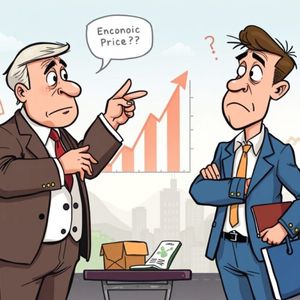BitcoinWorld Trump Tariffs Inflation: The Astonishing Claim Challenging Economic Norms A significant claim has recently emerged from former U.S. President Donald Trump regarding the complex relationship between trade policy and domestic economic stability. He firmly stated that the tariffs he imposed did not cause inflation and that consumers were not burdened by them. This perspective directly challenges conventional economic wisdom and warnings from prominent figures like Goldman Sachs CEO David Solomon. This declaration brings the debate around Trump tariffs inflation back into the spotlight, prompting a closer look at their actual economic impact. Are Trump Tariffs Really Inflation-Free? President Trump’s assertion, reported by Walter Bloomberg on X, posits that the financial weight of tariffs falls on the exporting nations, not American consumers. This viewpoint contradicts many economists who argue that tariffs, essentially taxes on imported goods, are typically passed on to consumers through higher prices. The timing of his comments is particularly interesting, following a July CPI report that showed a 2.7% year-over-year rise, which was slightly below the forecasted 2.8%. The core of this debate lies in understanding who truly pays for import duties. When a tariff is imposed, foreign producers might absorb some of the cost to remain competitive, or domestic importers might absorb it, or the cost is indeed passed on to the end consumer. Trump’s stance suggests a complete absorption by foreign entities, which is a less common outcome in economic models. Understanding the Economic Impact of Tariffs on Consumers Historically, tariffs have been implemented with various goals, including protecting domestic industries or influencing trade balances. However, a common side effect is often an increase in the cost of imported goods. This directly influences the consumer prices debate . For example, if tariffs are placed on steel, domestic manufacturers using that steel might face higher input costs, leading to more expensive cars or appliances for buyers. The discussion often revolves around whether consumers see these increases directly. While a consumer might not see a "tariff tax" on their receipt, the higher cost of goods can still erode their purchasing power. Goldman Sachs CEO David Solomon previously warned about potential market impacts, indicating a concern that these duties could indeed ripple through the economy and affect prices. Consider the real-world implications: Increased Production Costs: Businesses importing raw materials or components face higher expenses. Reduced Consumer Purchasing Power: If costs are passed on, consumers can buy less with the same money. Supply Chain Adjustments: Companies might seek alternative, potentially more expensive, suppliers. Navigating the US Inflation Outlook : Beyond Tariffs While tariffs are one factor, the overall US inflation outlook is influenced by a multitude of economic forces. Factors such as energy prices, wage growth, supply chain disruptions, and fiscal and monetary policies all play significant roles in determining the Consumer Price Index (CPI). The July CPI figure, at 2.7% year-over-year, indicates a moderated inflation rate compared to previous periods, but still represents an increase. Economists continuously analyze these various components to understand the true drivers of inflation. Attributing inflation solely to one factor, or dismissing the impact of another entirely, often oversimplifies a complex economic phenomenon. The current economic climate involves intricate global supply chains and dynamic market forces that can influence prices in unexpected ways. The Broader Trade Policy Effects and Future Considerations The debate surrounding Trump tariffs inflation extends beyond immediate price impacts. Trade policy decisions have long-term consequences for international relations, domestic industry competitiveness, and overall economic stability. Nations often use tariffs as a tool in trade negotiations, aiming to achieve specific strategic or economic advantages. However, these policies can also provoke retaliatory tariffs from other countries, potentially harming export-oriented domestic industries. Understanding the full spectrum of trade policy effects requires considering both the direct financial implications and the broader geopolitical and economic ramifications. The ongoing discussion about who bears the cost of tariffs remains crucial for policymakers and consumers alike. In conclusion, former President Trump’s assertion that tariffs do not spur inflation and are not paid by consumers challenges a widely held economic view. While the July CPI figures showed a moderate rise, the core debate about the true economic impact of tariffs continues. This complex issue involves multiple variables, from global supply chains to consumer behavior, and its resolution is vital for understanding the future direction of the US inflation outlook and broader economic stability. Frequently Asked Questions (FAQs) Q1: What is Donald Trump’s main claim regarding tariffs and inflation? A1: Former President Trump asserts that the tariffs he imposed did not cause inflation and that American consumers were not the ones bearing the cost. He believes the burden fell on the exporting nations. Q2: How do economists typically view the relationship between tariffs and inflation? A2: Most economists generally believe that tariffs, which are taxes on imported goods, are often passed on to consumers through higher prices, thus contributing to inflation. They can also increase production costs for domestic businesses. Q3: What role does the Consumer Price Index (CPI) play in this debate? A3: The CPI measures the average change over time in the prices paid by urban consumers for a market basket of consumer goods and services. In this context, the July CPI rising 2.7% year-over-year provides a data point for the overall inflation picture, which Trump’s claims address. Q4: Who is David Solomon, and what was his stance on tariffs? A4: David Solomon is the CEO of Goldman Sachs. He previously issued warnings about the potential negative market impacts of tariffs, suggesting they could indeed affect prices and the broader economy, a view that contrasts with Trump’s. Q5: Besides tariffs, what other factors influence the US inflation outlook? A5: The US inflation outlook is shaped by many factors, including energy prices, wage growth, global supply chain dynamics, and the fiscal and monetary policies implemented by the government and central bank. Did this article shed new light on the complex debate surrounding tariffs and their economic impact? Share your thoughts and this article with your network on social media to keep the conversation going! To learn more about the latest economic trends , explore our article on key developments shaping the US economy and its future outlook. This post Trump Tariffs Inflation: The Astonishing Claim Challenging Economic Norms first appeared on BitcoinWorld and is written by Editorial Team











